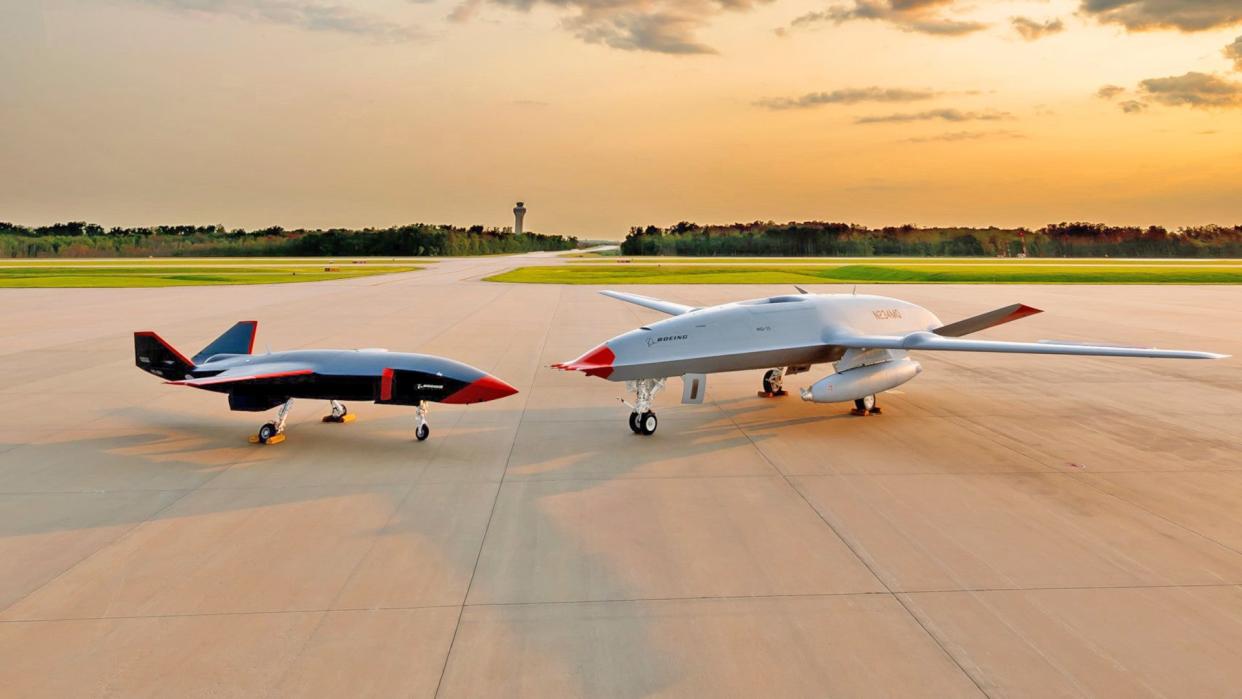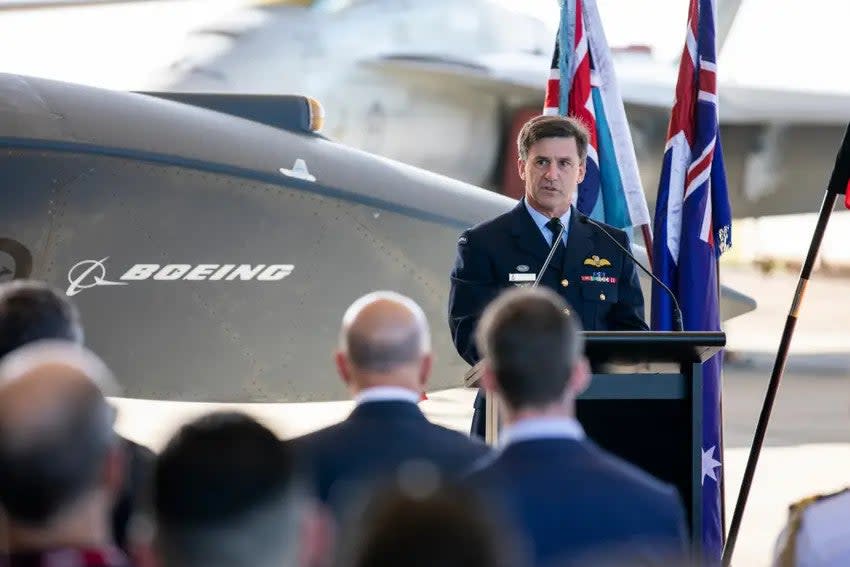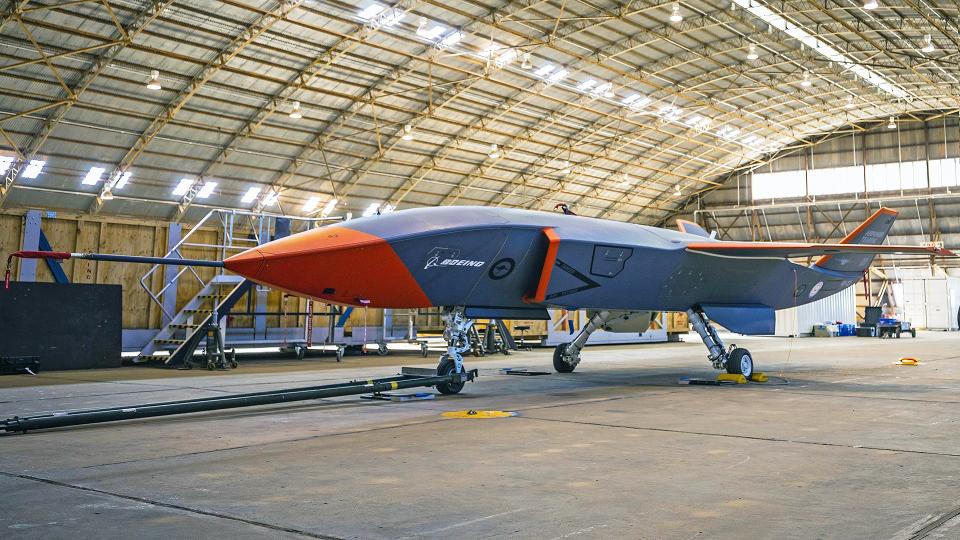First Image Of MQ-28 Ghost Bat In The United States

Boeing has released a picture showing an MQ-28 Ghost Bat, a "loyal wingman" type drone designed by its Australian subsidiary, alongside its demonstrator for the MQ-25 Stingray tanker drone that it is developing for the U.S. Navy. Last year, the Pentagon confirmed that it had acquired at least one MQ-28 to be used to support U.S. Air Force advanced uncrewed aircraft and autonomy efforts. Earlier this year, it also emerged that Boeing has at least put forward the idea of a carrier-capable variant of the Ghost Bat.
The picture of the MQ-28 and the MQ-25 demonstrator, the latter also known as the T1, side-by-side appeared on various Boeing social media accounts earlier today. Boeing did not say where or when the photograph was taken, but it clearly shows the two drones at MidAmerica Airport outside of St. Louis, Missouri, which is also known to be the home of the T1 demonstrator.
"Krystle Carr, Boeing’s director of autonomous collaborative platforms, acknowledged the drone had arrived for testing, but didn’t say when or for whom," according to a separate report today from Breaking Defense. "She declined to elaborate, and Boeing officials referred all further questions to the Air Force."
The War Zone has also reached out for more information.
"Our autonomous duo meets at last," according to a post from Boeing accompanying the picture on Twitter. "The MQ-28 Ghost Bat, developed in Australia, provides fighter-like performance to expand airborne missions. The MQ-25 Stingray refuels fighters to keep the mission going. That’s unmatched uncrewed airpower."
Boeing has been actively testing the T1, which also carries the U.S. civil registration code N234MQ, for years now as it works on creating the first production-representative prototypes of the Stingray for the Navy. As of April of this year, delays in the construction of those drones have pushed back the Navy's timeline for reaching initial operational capability with the MQ-25 by around a year to sometime in 2026. When they do enter service, the Stingrays will primarily provide aerial refueling support to the Navy's carrier air wings, but also have the ability to operate in a secondary intelligence, surveillance, and reconnaissance role.
What is now known as the MQ-28 Ghost Bat first appeared publicly, somewhat out of nowhere, in 2019, after initial development in secret under the Airpower Teaming System (ATS) program for the Royal Australian Air Force (RAAF). Three prototypes have since been built and flight tested, and work has been continuing to expand its flight envelope and capabilities.
In terms of the new capabilities being added to the RAAF's prototype MQ-28s, this includes the installation of an infrared search and track (IRST) sensor system in the nose of one, as seen in the picture below. This highlights the drone's highly modular design and open-architecture missions system. The centerpiece of the Ghost Bat's modularity is the ability to swap out entire nose sections with different sensors and other systems, as you can read more about here.

As of May 2022, the RAAF was expected to eventually acquire at least 10 MQ-28s, at least initially, and begin using them operationally by 2025. The drones are expected to work closely together with Australia's crewed combat jet fleets, which currently consist of F-35A Joint Strike Fighters and F/A-18F Super Hornets, to carry out a variety of missions.
As already noted, in 2022, the Pentagon confirmed that its Office of the Undersecretary of Defense for Research and Engineering had acquired at least one MQ-28 on behalf of the Air Force. It remains unclear what the service is using the Ghost Bat platform for, but Secretary of the Air Force Frank Kendall has said in the past that it is a "technology feeder" for the Collaborative Combat Aircraft (CCA) program. The Air Force is leveraging work that has been done in recent years through a number of advanced drone and autonomy projects to support the CCA effort.
Under CCA, which is part of the Air Force's broader Next Generation Air Dominance (NGAD) program, the service is seeking to acquire at least one type of advanced drone with a high degree of autonomy that will work closely with crewed platforms. At present, the Air Force is planning to buy at least 1,000 CCAs, but that figure could grow in the future and might eventually include multiple distinct types of uncrewed aircraft. The 1,000 CCA number was based on a concept of operation that would part two of these drones with each one of the 200 sixth-generation stealth crewed combat jets the Air Force is also looking to purchase under NGAD, as well as 300 F-35A Joint Strike Fighters.
Boeing has pitched the idea of the MQ-28, or a variant or derivative thereof, as a contender in the forthcoming CCA competition, which is expected to be very high stakes. The company had previously received an Air Force contract to deliver examples of this drone to support the service's Skyborg advanced drone program, which is also feeding into CCA. Boeing's involvement in Skyborg came to an end before it delivered any aircraft due to conflicts with testing schedules for the RAAF's ATS program.

The U.S. Navy is also cooperating closely with the Air Force on various aspects of the CCA effort, as well as the Air Force's larger NGAD initiative. This includes plans for both services to be able to pass control of each other's CCAs and CCA-like drones back and forth during future operations. The Navy has its own separate NGAD program, which is currently focused heavily on the development of a new sixth-generation carrier-capable stealth combat jet, referred to as F/A-XX.
The Navy views F/A-XX as an important component of future carrier air wings. The service also expects 60 percent or more of the aircraft embarked on its flattops to eventually be uncrewed. One of F/A-XX's expected roles will be acting as an aerial control node for those drones.
In February, Royal Navy Rear Adm. James Parkin, who currently holds the somewhat confusing title of Director Develop for that service, gave a presentation at the 2023 International Military Helicopter conference in London. His briefing slides included one with a rendering showing a variant or derivative of the MQ-28 with a visible tail hook landing on a carrier.
Boeing confirmed to The War Zone at that time that this is official company artwork, but could not provide any further details about it. A carrier-capable drone based on the MQ-28 could be of interest to the U.S. Navy, as well as the Royal Navy.
Separately, the U.K. Ministry of Defense released documents earlier this month that indicated the Royal Navy would trial General Atomics' new short takeoff and landing-focused Mojave drone, which you can read more about here, as a possible addition to the air wings for its two Queen Elizabeth class carriers.
It is worth noting that the Queen Elizabeth class design, at least currently, has a so-called short takeoff and vertical landing (STOVL) configuration without catapults or arresting gear. This means that it isn't capable of recovering any aircraft using a tail hook. This had already prompted questions about the context behind the MQ-28 rendering in Rear Adm. Parkin's briefing. Adding arresting gear and even catapults to ships with large flight decks, specifically to support drone operations, is something that navies around the world, such as Turkey and China, are increasingly showing interest in.
After the British documents about emerged, General Atomics' spokesperson C. Mark Brinkley posted a number of Tweets where he did not confirm or deny plans to conduct a carrier-based demonstration of Mojave. However, he did note that Mojave has been designed with this in mind from the start and that General Atomics has been "discussing that with fleets worldwide." He also pointed out that the company is developing a conversion kit for MQ-9 Reapers that would allow them to operate from carriers and amphibious assault ships.
For Boeing, it will be interesting to see what may happen with its two flagship drone programs, the MQ-25 and the MQ-28, now that examples of both are not only in the United States, but have 'met.'
Contact the author: joe@thedrive.com

